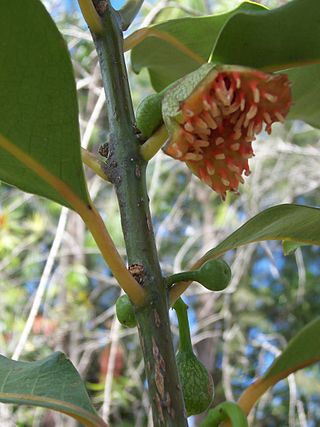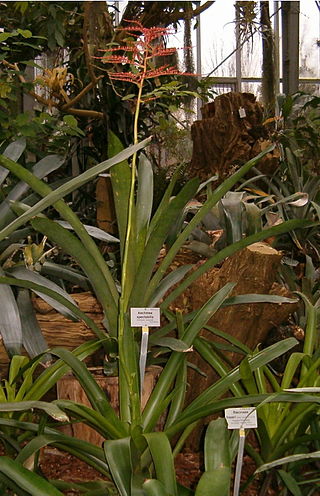
The Monimiaceae is a family of flowering plants in the magnoliid order Laurales. It is closely related to the families Hernandiaceae and Lauraceae. It consists of shrubs, small trees, and a few lianas of the tropics and subtropics, mostly in the southern hemisphere. The largest center of diversity is New Guinea, with about 75 species. Lesser centres of diversity are Madagascar, Australia, and the neotropics. Africa has one species, Xymalos monospora, as does Southern Chile. Several species are distributed through Malesia and the southwest Pacific.
In linear algebra, it is often important to know which vectors have their directions unchanged by a linear transformation. An eigenvector or characteristic vector is such a vector. Thus an eigenvector of a linear transformation is scaled by a constant factor when the linear transformation is applied to it: . The corresponding eigenvalue, characteristic value, or characteristic root is the multiplying factor .

Siparunaceae is a family of flowering plants in the magnoliid order Laurales. It consists of two genera of woody plants, with essential oils: Glossocalyx in West Africa and Siparuna in the neotropics. Glossocalyx is monospecific and Siparuna has about 74 known species.

Racinaea is a genus of the flowering plants in the family Bromeliaceae, subfamily Tillandsioideae. The genus is named for Racine Foster, wife of Mulford B. Foster and co-founder of the BSI. It is found in tropical regions of the Americas.
Siparuna lozaniana is an evergreen dioecious shrub which usually grows to 8 m in height. It is found in wet montane forest habitats in central Colombia. It can be distinguished from Colombian congeners such as Siparuna calantha and Siparuna petiolaris by the combination of leathery oblanceolate or obovate leaves and smooth rather than spiny fruits.
Siparuna vasqueziana is an evergreen dioecious shrub which grows to 5 m in height. It is found in primary forest habitats in Amazonian Peru. It can be distinguished from all other Siparuna species by its yellow flowers with exceptionally long tepals.
Siparuna campii is a species of plant in the Siparunaceae family. It is endemic to Ecuador.
Siparuna cascada is a species of plant in the Siparunaceae family. It is endemic to Ecuador.
Siparuna croatii is a species of plant in the Siparunaceae family. It is endemic to Ecuador.
Siparuna eggersii is a scrambling, large shrub in the Siparunaceae family. It is endemic to Ecuador, where it is endangered due to habitat destruction. It has glabrous leaves and fig-like, red fruit with a lemon scent.
Siparuna guajalitensis is a species of plant in the Siparunaceae family. It is endemic to Ecuador.
Siparuna multiflora is a species of plant in the Siparunaceae family. It is endemic to Ecuador.
Siparuna piloso-lepidota is a species of plant in the Siparunaceae family. It is endemic to Ecuador.

Temperature is a physical quantity that expresses quantitatively the attribute of hotness or coldness. Temperature is measured with a thermometer. It reflects the kinetic energy of the vibrating and colliding atoms making up a substance.
S. nigra is an abbreviation of a species name. In binomial nomenclature the name of a species is always the name of the genus to which the species belongs, followed by the species name. In S. nigra the genus name has been abbreviated to S. and the species has been spelled out in full. In a document that uses this abbreviation it should always be clear from the context which genus name has been abbreviated.
S. petiolaris may refer to:
Nebulosa elicioi is a moth of the family Notodontidae first described by James S. Miller in 2008. It is endemic to the eastern slope of the Ecuadorian Andes.
Hyaleucerea lemoulti is a moth of the subfamily Arctiinae. It was described by Schaus in 1905. It is found in Ecuador and French Guiana.
S. poeppigii may refer to:
Curarea is a genus of flowering plants in the family Menispermaceae, found in tropical parts of Central and South America. They are dioecious lianas, with at least some species producing toxic compounds such as curare.



